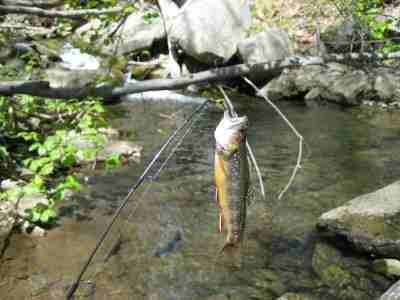I thought the Rose was good… until I hiked into the Hughes. It was about an 8 mile round trip from the lower end by the Rag Mountain Parking lot – but worth every step.
We hit the Hughes on April 29 – cool day – about 65 at the top of the afternoon and sunny. You start the trail on private property and have about a 1/2 mile hike to get to the National Park. As soon as you see the river, it tempts you with high flows, deep pools and plenty of space to flick a fly or spinning rod. But, this close to the road, these spots have to be hit pretty hard, so Dick and I continued up the trail until we hit the junction of the Hughes with Hannah Run.
Hannah Run was a pathetic little stream – kind of like Jeremy’s Run. I caught some fish on it, but it was not fun. Dick went right over to the Hughes and started working it – but this section was heavily trashed with deadfall and boulders that made it very difficult to work the fly fishing magic. I linked up with him after my recon of Hannah and we decided to head farther north – glad we did!
The trail crosses the river at a deep pool. Mark this spot as this is where you want to start fishing. We did not know that and continued on farther north given the discussion in the books of the great fishing up by Corbin Cabin.
The Corbin Cabin area is another Jeremy’s Run. Low flow and few pools. Dick and I split up here. He headed back south to fish the deep part of the river south of the Hannah Run junction.
I pressed on to confirm the nature of the flow in this area (bad) and, on the way back, discovered the the section marked on the map above with the three waypoints at the northern end.
This is the mother lode of deep pools and fast runs. The terrain takes a pitch downward and that is enough to allow the water to collect and form an intricate series of honey holes that you just have to experience. It’s tough crawling and climbing to get to all of them, but the fish are there!


I attached the elevation profile so you can see the vertical gain associated with this hike. To go all the way up to where I stopped, it’s about a 1,000 foot gain – but it is an easy, well marked trail. No danger of getting lost.
We only saw one other fisherman north of the first set of waypoints. This is a low pressure area.
Getting there: To get to the southern entrance of the Hughes, go south from Sperryville on 231 and turn off on 602 towards Nethers. Continue until you get to the Rag Mountain lot and walk up the road until you see the concrete trail marker. Follow the Nicholson Hollow Trail – it runs right next to the Hughes.

This is the junction of the Hughes and the Hannah – ignore the Hannah and stay on the trail. You have to go about another 1/2 mile before you reach the good spot.

This is the upper Hughes. Not a great looking stream. Few pools and shallow.

This is the deep pool where the River crosses the trail. You can walk farther north and cut over to the River or just start crawling over the rocks here and work upstream.

We stopped for lunch up here at the upper end. Bring water!

I fished north on the upper Hughes to confirm whether it was OK or not – caught some nice fish as shown here – but it just was few and far between.

Plenty of deadfall makes access to the River difficult – but – that’s good for keeping the pressure down

This picture was taken at the top waypoint on the map. This is the start of the good stretch as you fish downstream. Caught about 3 nice fish right here.

Typical upper Hughes nice fish. All fish were immediately released.

Look at this pool! Deep water and full of fish.

Another scenic spot – I could fill a bunch of pages with this type of picture – the upper Hughes is full of spots like this.

Nice fish – this guy was about 7 or 8 inches
I used two lures all day. I started out the a gold flash and black body Panther-Martin and switched to the silver and yellow later in the day.

Diverse population!
Remember that the Shenandoah Park is a special regulation area – only artificial lures with one hook are permitted. Take your wire snips to trim down your treble hooks.
Unless stated otherwise, this article was authored by Steve Moore


